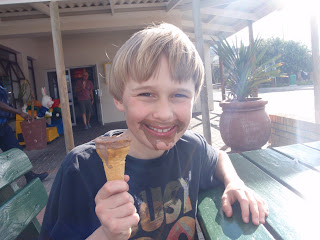The day was capped of with an encounter with the South African Penguin colony, at Boulders Beach in Table Mountain National Park near the southern tip of the Cape of Good Hope. These penguins are only found in South Africa, in these warm False Bay waters, and seem to wander quite freely, indifferent to the viewers and residential houses along the shores. The kids spent time spotting all the eggs in the nests (an early Easter egg hunt) and were amused at the penguins waddling style. Ben has become our keen videographer, and ensured that we got ample footage of the penguins in action. Supposedly you can also swim with the penguins, but we arrived at the end of the day, as the sun was setting and decided this would be best in warmer conditions.
On our drive back down the Cape, we encountered a pack of baboons, enjoying the lingering heat from the road - at the risk of traffic ...... and a wild species of Kite Surfers at Scarborough Beach - keen and indigenous to these parts. Scarborough beach appears to be the "hippy-surf" hang out - with it's beautiful white sands, rocky shoreline and wave action.
Our drive back home, took us along Chapman Peaks Drive, an incredible pass through the mountains from Hout Bay to Noordhoek. While the eastern flank of the mountain rises fairly gradually, the western flank falls sharply for hundreds of metres into the Atlantic Ocean. Separating the road from the 250 m drop to the ocean, are a few sporadic rocks-barriers, so this drive is not for the faint of heart. We marvelled at the overhanging rock formations, which extended over the road and also the string of road signs marking "falling rock". The top of Chapman's Peak consists of flat, sedimentary rocks related to those that form Table Mountain. The base of the mountain, however, consists of Cape Granite and the two formations meet at a geological unconformity that is world-famous amongst earth scientists. The pass was "hacked" out of the face of the mountain between 1915 and 1922, and was at the time regarded as a major feat of engineering (always looking for great engineering landmarks too!).





















